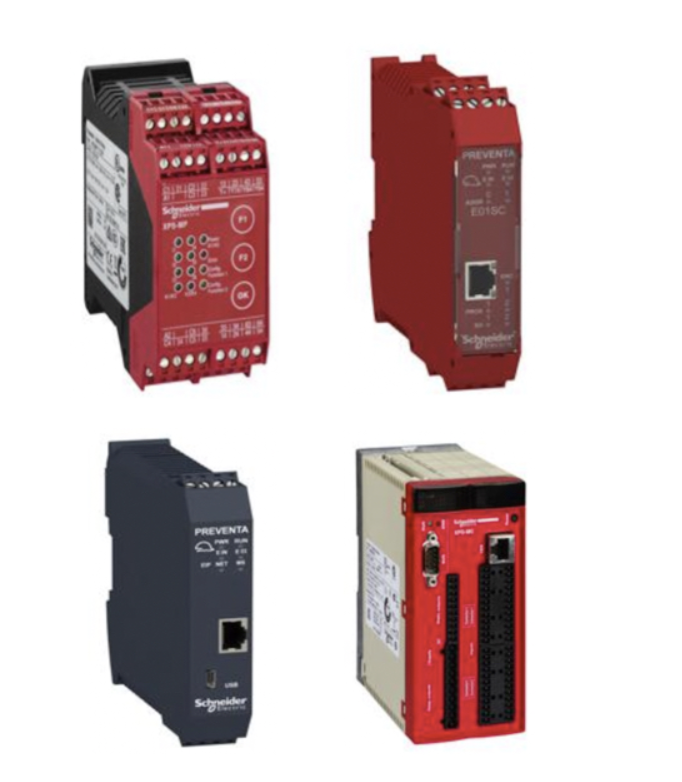Safety PLCs

Safety PLCs, or safety programmable logic controllers, are specialized control systems designed to execute safety functions alongside standard automation tasks. Compared to conventional programmable logic controllers, safety PLCs have a redundant internal architecture and built-in diagnostics that qualify them to meet safety requirements in industrial environments. They are used in safety applications where "functional safety" is critical. Some examples of the safety applications are emergency stop systems, safety light curtains, and machinery guarding. The inputs from safety sensors and devices are processed by the safety PLC. During an abnormal or dangerous situation, the safety PLC governs hazardous equipment so that it responds reliably.
Safety PLCs can run a dedicated safety program either independently or alongside standard process control logic. A safety PLC uses a safety logic structure, which includes safety relays, program flow control, and safety blocks, to handle safety-related functions without interfering with normal operations. This integration of safety functions allows engineers to build systems that meet the compliance requirements of international safety standards, like IEC 61508 and ISO 13849. These standards define the required safety integrity level (SIL) or performance level (PL). SILs and PLs govern how safety functions must behave under fault conditions to minimize risks to personnel and equipment.
More Information about Safety PLCs
In intricate industrial operations, safety PLCs often play a role in a larger safety instrumented system (SIS). These safety systems combine safety components such as sensors, actuators, and logic solvers to manage and mitigate identified risks and hazards. The SIS's "brain" not only makes decisions and controls actions that are safe but also ensures that it is doing so in a reliable manner. Since PLC part of the SIS is so often assumed to provide integrated safety functions in a reliable manner, it is referred to as a "safety PLC."
FAQs
How does safety logic help prevent potential failures in automated processes?
Safety logic helps prevent potential failures in automated processes by continuously monitoring inputs, detecting anomalies, and executing predefined actions to transition systems into a safe state, thereby mitigating risks and ensuring process integrity.
What are some of the stringent safety requirements and safety regulations that safety devices, like safety PLCs must follow?
Safety devices like safety PLCs must comply with stringent safety requirements and regulations such as IEC 61508 for functional safety, ISO 13849 for machinery safety, and IEC 62061 for safety-related control systems, which define performance levels, safety integrity levels (SIL), and risk assessment protocols.
PLCs
Programming Logic Controllers (PLCs) are industrial computer that are designed to monitor and control a series of inputs and outputs.
The program running the PLC evaluates the inputs, and changes the output signals based on the program response to the input signals. Several programming languages are available to program most PLCs. The most common of these is called ladder logic. Ladder logic is a visual programming language that evolved from relay logic diagrams, which visually look like ladders because they consist of two vertical rails with runs between them that contain programmed logic. While ladder logic is the most common programming language used within PLCs, there are others that are also common, including function block diagrams, structured text and sequential function charts.
The hardware included in a PLC includes: a CPU, memory, I/O connections, a power supply and a programming device.
The CPU is a microprocessor that acts as the brains of the PLC. It performs logic operations, controls instruction and performs various other tasks that help keep the PLC running effectively. The memory in a PLC allows data to be stored that is needed to run the program, as well as any data that is collected by the inputs. Depending on the the type of PLC, the section for I/O may have a fixed number of points or it may be modular, allowing for additional I/O to be added. Many PLCs require some type of power supply and it is common to see more modular based systems integrate the power supply. Lastly, the PLC provides a programming device that feeds the program into the PLC's memory, so that it can perform the desired operation. This is most commonly some type of computer.
The PLC is designed to run a program repeatedly over and over again, normally many times a second. Each time a program runs, the PLC goes through some very specific steps.
While the order and the specifics may vary from manufacturer to manufacturer, they all typically follow a pattern similar to the following:
The PLC performs internal self checks to make sure that it is functioning correctly.
The PLC reads the inputs that are connected to it. It will then store the status of each of those inputs in its memory.
The PLC will execute the program logic.
The PLC will write the new values to the hard wired outputs to match those determined during the program execution. At some point in the cycle, communication requests will also be processed.
Following the execution of the last step, the PLC will then cycle back to the beginning of the process and begin all over again.

